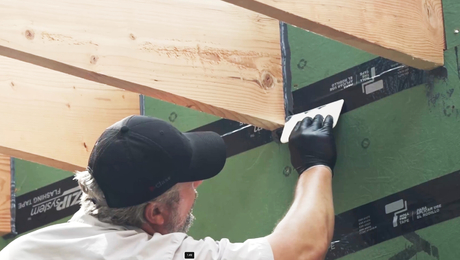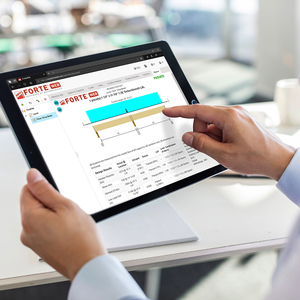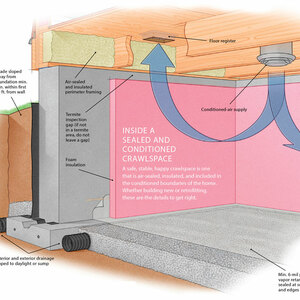What is the real story of taking the mileage deduction on income taxes? Everyone has a diffrent take inc. my accountant and my girlfriends accountant.. Worked 4 diffrent jobs over course of last year. Driving my work truck(not depreciated anymore) hauling my tools and lots of times materials picked up on way.Some people call it “commuting” if im going to same job for awhile others not. I know straight material trips are okay but what about back and forth to a “temporary” job location? This is a great deduction for me so would like to hear others take on this.Thanks!
Discussion Forum
Discussion Forum
Up Next
Video Shorts
Featured Story

In issue #314, Fine Homebuilding published an article titled “The End of Deep Energy Retrofits” by Rachel White of Byggmeister. The premise was that deep energy retrofits are not as…
Featured Video
How to Install Cable Rail Around Wood-Post CornersHighlights
"I have learned so much thanks to the searchable articles on the FHB website. I can confidently say that I expect to be a life-long subscriber." - M.K.

















Replies
were you driving there for an employer? I know my guys take the mileage deduction, it helps them a bunch.
An inch too short. That's the story of my life !
bstcrpntr --- I hope to grow into this name.
Nope ; these are all jobs where im the boss; or independent contractor.
If you were depreciating your truck and that infers you were taking actual expenses, you cannot switch over to the milage deduction for that vehicle. You must continue with that method.
Otherwise, business milage for 2006 is .445/mile and the IRS frowns upon deducting commute milage. Commute milage is normally from home to your first stop of the day and then from your last stop of the day to home. Everthing in between is fair game.
The first and last stop of the day do not necessarily have to be a job location, just a location from which you can offically begin and end your business day. If you can somehow pull out of your drive way and then pull immediately into the drive leading to your material storage you satisfy the commute, no matter how short it is. A trip to your bank at the end of the block for a deposit, a notarized signature, or a book of stamps for your business use will also be a commute but a very short one so you can start recording your deductible milage. Likewise, ending the day at the nearest hardware store to your house milks the most business milage. Documentation is the key.
so open an office in your garage, then it be home to office, mileage office to home.. BOB thinks I,m an idiot
What about if the home office is in a spare bedroom? That's where every day starts for me! Then I commute on foot out to my truck and drive to my next stop.
You (or you accountant) will have to do some reading of fine points and probably looking up of the IRS and court rulings."That about if the home office is in a spare bedroom? That's where every day starts for me! Then I commute on foot out to my truck and drive to my next stop."I think that depends of if the office if your "principle place of business" or not.For example do you spend 15 minutes in the morning checking your scheule and maybe 30 minutes each night update the reports and loging in the job, but the rest of the time you have been on one job site hammer nails.Or do you spend 4 hours a day working on designs, doing proposals, contacting subs, etc and makey 2 hours at different locations making sales calls and another 2 hours at 2 different sites checking jobs.In either case you can have a home office (assuming other rules are met).
Here is chapter 4 of the IRS pub 463 on Transportation Expenses.Anyone interested needs to read the whole thing.http://www.irs.gov/publications/p463/ch04.htmlBut here are a couple of highlites."No regular place of work. If you have no regular place of work but ordinarily work in the metropolitan area where you live, you can deduct daily transportation costs between home and a temporary work site outside that metropolitan area. Generally, a metropolitan area includes the area within the city limits and the suburbs that are considered part of that metropolitan area. You cannot deduct daily transportation costs between your home and temporary work sites within your metropolitan area. These are nondeductible commuting expenses.""Hauling tools or instruments. Hauling tools or instruments in your car while commuting to and from work does not make your car expenses deductible. However, you can deduct any additional costs you have for hauling tools or instruments (such as for renting a trailer you tow with your car).""Office in the home. If you have an office in your home that qualifies as a principal place of business, you can deduct your daily transportation costs between your home and another work location in the same trade or business. (See Publication 587, Business Use of Your Home, for information on determining if your home office qualifies as a principal place of business.)'I was right David."Qualified nonpersonal use vehicles. These are vehicles that by their nature are not likely to be used more than a minimal amount for personal purposes. They include trucks and vans that have been specially modified so that they are not likely to be used more than a minimal amount for personal purposes, such as by installation of permanent shelving and painting the vehicle to display advertising or the company's name. Delivery trucks with seating only for the driver, or only for the driver plus a folding jump seat are qualified nonpersonal use vehicles."I am not sure, but I don't think that affects the deduction of milage or operating expesnes, only the limitations on depreciation, but I am not sure.
My understanding is that if you need your vehicle for work then it is deductible.
"My understanding is that if you need your vehicle for work then it is deductible."NEEDING it has nothing to do with deductibility.
I should have said that if it is required.Employees can take the deduction if it is required for their work.You can take the deduction if it is not your regular place of work such as a permanent building which is a regular place of employment.
Edited 3/23/2006 12:40 am by gb93433
Not exactly.Read this http://www.irs.gov/publications/p463/ch04.html
"Temporary work location. If you have one or more regular work locations away from your home and you commute to a temporary work location in the same trade or business, you can deduct the expenses of the daily round-trip transportation between your home and the temporary location, regardless of distance."I think the above quote is the critcial issue. Certainly construction would normally qualify.
Well 16 reponses later and people are still kinda vague.Glad i started this thread. Seems to be murky area. My accountant says.."take it". Some days i visit more than one job and most time hauling something essential for job (besides me).Plus i have a wood shop in town I stop at alot of mornings to meet helpers or run a few boards before heading to job. I aint Kenneth Lay but at 8000 miles this is a good hit. By way Mileage before Aug. is $.40 and after $.48
Mileage before Aug. is $.40 and after $.48
Those are last year's rates, and I think they were .405 and .485. This year so far it's 44.5 cents per mile.
No construction would not.What you are missing is the REGULAR Work location.What is says is that if you have REGULAR WORK LOCATION, but are temporary assigned to a another location (for less than a year) then you can deduct milage from the home.I one IRS put they give an example. IIRC it was an CPA that normally worked in the office, but was asigned to work in the clients for several months to do an aduit.This one is more typically for construction workers. Highlight added."NO REGULAR PLACE OF WORK. If you have no regular place of work but ordinarily work in the metropolitan area where you live, you can deduct daily transportation costs between home and a temporary work site OUTSIDE OF THAT METROPLITAN AREA. Generally, a metropolitan area includes the area within the city limits and the suburbs that are considered part of that metropolitan area. YOU CANNOT DEDUCT DAILY TRANSPORTATION COSTS BETWEEN YOUR HOME AND TEMPORARY WORK SITES WITHIN THE METROPLITAN AREA. THESE ARE NONDEDUCTIBLE COMMUTING EXPENSES."Here are some examples from that pub."Example 1.You regularly work in an office in the city where you live. Your employer sends you to a one-week training session at a different office in the same city. You travel directly from your home to the training location and return each day. You can deduct the cost of your daily round-trip transportation between your home and the training location.Example 2.Your principal place of business is in your home. You can deduct the cost of round-trip transportation between your qualifying home office and your client's or customer's place of business.Example 3.You have no regular office, and you do not have an office in your home. In this case, the location of your first business contact is considered your office. Transportation expenses between your home and this first contact are nondeductible commuting expenses. Transportation expenses between your last business contact and your home are also nondeductible commuting expenses. Although you cannot deduct the costs of these trips, you can deduct the costs of going from one client or customer to another."
Ralph,
Doesn't a lot of that have to do with how the truck is registered and insured? For example, if it is registered to a Business and the business office is a home office, You can start the clock as soon as you leave the driveway? If it's registered as private, you must first "Commute" to the shop or office and then everythign after that is work miles.
"Doesn't a lot of that have to do with how the truck is registered and insured? For example, if it is registered to a Business and the business office is a home office, You can start the clock as soon as you leave the driveway? If it's registered as private, you must first "Commute" to the shop or office and then everythign after that is work miles."Not realy.And it does not significally differ if you are an employee or SE. The main difference is if you are SE (or other business entity) you have more options in defining where you first buisness stop is.
Here's a cut and paste directly from the IRS website.
Office in the home. If you have an office in your home that qualifies as a principal place of business, you can deduct your daily transportation costs between your home and another work location in the same trade or business. (See Publication 587, Business Use of Your Home, for information on determining if your home office qualifies as a principal place of business.)
This is exactly how I work it, my earlier statement obviously not clear.
The OP didn't say if he had a home office or if his vehicle was privately owned or company owned.
I own my truck under my private name and use it exclusively for my corporations business. My corporation cuts me an expense check based on the total number of miles I rack up every month plus any other out of pocket costs I incur on behalf of the corporation, such as parking, tolls, etc. Even though it's a private vehicle, things like damage on a jobsite (busted tail light assembly, for instance) are legitimate corporate expenses and get reimbursed through the monthly expense check. I just have to be careful with the record keeping and not pay milage if the truck is used for non-business transportation.
Another great thing about milage reimbursement is that it is not limited to the truck I use every day. The best example I can give is the business milage reimbursement I take for the annual trip to a Fest. Since the Fests are organized as seminars and have a business value I carefully separate out the personal milage accrued on these trips and the corporation cuts me a check for the remaining business miles. This is so much better when the car I use to get to the Fest gets better than twice the average milage I get with the work truck. I also take the car on client visits, trips to the engineers office and the permit office.
Many of us keep our vehicles on the road for more years than you can claim depreciation so once you have maxed out depreciation all you have left is the actual expenses. In this case, the milage deduction gives more bang for the buck, so to speak.